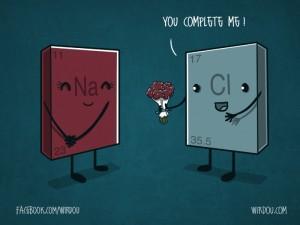
I once got a bad review claiming my novel LOVE FINDS YOU IN SUN VALLEY, IDAHO “awoke love too early.” And I couldn’t help being proud of it. Because, hey, that means I’m good at creating chemistry, right?
There’s nothing worse than reading (or watching) a story where there’s no chemistry between the characters. This doesn’t mean love-making. It means the unique, dynamic interaction between two characters that creates enough sparks for others to notice. Maybe the chemistry is that they propel each other away like the polarity of magnets or maybe they stir each other up to the point of creating inner cyclones. (For my characters, it was a kiss that had Emily’s oven mitts falling to the ground.) But whatever the chemistry, if it’s done right, it will hook readers into wanting to know what happens next.
So how should writers handle chemistry in Christian Romance, a market where it can be condemned as sinful? If good writing contains all three aspects of human existence—body, soul, and mind—how can we honestly depict the physical without overpowering the emotional and spiritual? I look to some of my favorite authors to help me learn to do just that.
Be true to the physical desire. I will never forget the scene from Kristen Heitzmann’s FREEFALL where the heroine asks the hero what he is thinking about, and he responds that he’s thinking about making love to her. What? In a Christian novel?
But why not? It’s human. It’s tempting. It’s real. The fact that he admits to thinking about it but chooses to keep his commitment to God is a powerful example for readers. It shows the difference between lust and love in a world that so often gets the two confused. Not every hero is going to come right out and say this, but here such dialog is true to the character Heitzmann created.
Show passion. I read my all-time favorite novel THE SCARLET PIMPERNEL for the first time in 8th grade. I had this crazy reading teacher who used to call us all hernias, and she got really excited about books.
“Ohhh,” she swooned, hugging the hardcover to her chest and whirling about the room. “Tomorrow’s chapter is so passionate!”
My best friend raised her eyebrows at me. “I read ahead, and they don’t even kiss.”
If you’ve read the story, you probably know that they don’t kiss. It’s a husband and wife who ache to tell each other the truth about their troubles, but they’re afraid to trust. So she takes off, and he kneels to the ground where he kisses the steps she’d been standing on. Now that’s passion. Definitely G-rated, but the reader is sure to feel it.
Be discreet. Non-Christian characters don’t worry about the soul part of themselves as much as the physical part. They might not hold back. So how do you clue the reader in without crossing the line?
Francine River wrote about a prostitute in REDEEMING LOVE. Frank Peretti used fornication to make a point in PROPHET. Denise Hunter had a love scene between husband and wife in THE CONVENIENT GROOM. But rather than depict the actions, they dealt with the emotional reactions.
I especially admire Deeanne Gist’s use of the symbol of the purity necklace in her book A BRIDE MOST BEGRUDGING. Josh knows his brother slept with his bride because she’s wearing his necklace. This shows a connection needed to intensify the chemistry without showing the actual connection.
We can relate to these different circumstances, not because we know what it’s like to be a prostitute or in an estranged marriage, but because we’ve all felt chemistry before. So I’ll end with the advice of Brandilyn Collins in her book GETTING INTO CHARACTER. “An author carries within himself the seed for every emotion and desire he may create within a character.” This means if you tap into your own experience with chemistry—whether it be puppy love or an inspiring partnership—you can use it to create believable chemistry for your Christian Romance.
